The Archaeology of La Calsada |
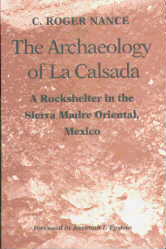
THE ARCHAEOLOGY OF
LA CALSADA
A ROCKSHELTER IN THE
SIERRA MADRE ORIENTAL, MEXICO
By C. Roger Nance
UNIVERSITY OF TEXAS PRESS - Austin
Copyright ©1992 by the University of Texas Press
STATED: FIRST EDITION, 1992
ISBN: 0-292-70427-5
Printed in the United States of America.
THE ARCHAEOLOGY OF LA CALSADA
(from the dust-jacket end-flaps)
"...[The Archaeology of La Calsada] is a pioneering effort..."
- Harry J. Shafer, professor of anthropology, Texas A&M University.
On a remote mountainside, 2,000 meters above sea level in the northern Sierra Madre Oriental, the rock-shelter at La Calsada has yielded basic archaeological data for one of the least understood regions of prehistoric North America, the state of Nuevo Leon in northern Mexico. This comprehensive site report, with detailed information on artifacts and stratigraphy, provides baseline data for further explorations in the region and comparisons with other North American gatherer-hunter groups.
Radiocarbon dating traces the earliest component at the site to 8600-7500 B.C., giving La Calsada arguably the earliest well-dated lithic complex in Mexico. Nance describes some 1,140 recovered stone tools, with comparisons to the archaeology of South and Southwest Texas, as well as reported sites in Tamaulipas, Coahuila, and Nuevo Leon, Mexico.
From the lithic and stratigraphic analysis, Nance deduces occupational patterns at the site, beginning with Paleo-Indian cultures that lived in the area until about 7500 B.C. Through changes in tool technology, he follows the rise of the Abasolo tradition around 3000 B.C. and the appearance of a new culture with a radically different lithic industry around A.D. 1000.
With both temporal depth and clear stratigraphy, La Calsada is a foundational site for study of North American prehistory. The Archaeology of La Calsada will be important reading for all scholars and amateurs working in the region.
Hard-back book measures roughly ~6-1/4" by ~9-1/4" (portrait); ~7/8" thick; 234 pages, no tears or folds; binding fully intact. Book and dust-jacket are in very-fine "NEW" condition.
Price is $19.99 U.S.
Return to top of page.
The ARCHAEOLOGY of WEAPONS |
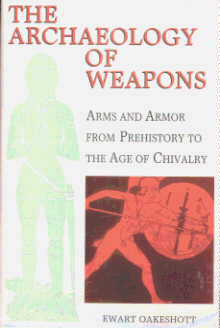
THE ARCHAEOLOGY OF WEAPONS
ARMS AND ARMOR FROM PREHISTORY TO THE AGE OF CHIVALRY
By Ewart Oakeshott
BARNES AND NOBLE BOOKS - New York - 1994
Copyright ©1960 by R. Ewart Oakeshott.
ISBN: 1-56619-596-9
Printed in the United States of America
THE ARCHAEOLOGY OF WEAPONS
(from the dust-jacket end-flaps)
In The Archaeology of Weapons, Ewart Oakeshott, an authority on medieval arms in Europe, presents a full, accurate, and readable account of the development and use of arms from the Bronze Age to the Age of Chivalry. His argument is based upon evidence of arms found in excavations, tombs, rivers and the ground, as well as in contemporary art. To this evidence, he adds descriptions from the literature of the times, giving life to the archaeological material and clarifying many of the issues which archaeology alone cannot explain. The text is illustrated with more than 170 drawings and 39 plates, 17 of which have been added for this edition. The book also includes a new preface by the author.
Oakeshott's aim is to show the development of arms in an unbroken sequence, and to present the archaeological material in its proper place within the framework of history. The Archaeology of Weapons is divided into four sections. The first covers the Bronze and Iron Ages, and the second the great folk migrations and the breakup of the Roman Empire. From this period, crucial to the development of the art of war, comes the most interesting material, the great burial of arms left by the Celtic and Teutonic peoples of northwestern Europe. These finds are discussed in detail alongside the historical background, and the one lends life and meaning to the other.
The third section covers the age of the Vikings, and includes much vivid literary material. The fourth section, dealing with the Age of Chivalry, is the real core of the book; following a general survey of the institution of chivalry itself, an understanding of which is vital to the correct appreciation of all the arms of the High Middle Ages, is a classification of medieval sword types from about A.D. 1050 to A.D. 1500. The human aspect of the sword is treated as an essential part of this lucid study and adds much to its archaeological interest.
From the evidence of his material, from the conclusions of many archaeologists and historians, and from his own detailed research, the author presents this definitive study of the weapons of thirty centuries.
Ewart Oakeshott is one of the world's leading authorities on the arms and armour of medieval Europe. His other works on the subject include Records of the Medieval Sword and The Sword in the Age of Chivalry, both standard works of reference in the field.
Hard-back book measures roughly ~6-3/8" by ~9-1/4" (portrait); ~1-1/4" thick; 359 pages; no tears or folds in pages; binding fully intact; very-minor shelf-scuffing and wear (mainly to dust-jacket). Book and dust-jacket are in otherwise very-good to fine condition.
!SOLD OUT!
Return to top of page.
The Code of Kings |
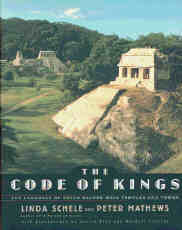
THE
CODE OF KINGS
THE LANGUAGE OF SEVEN
SACRED MAYA TEMPLES AND TOMBS
By Linda Schele and Peter Mathews
SCRIBNER - Reno and Las Vegas
Copyright ©1998 by Linda Schele, Peter Mathews, Justin Kerr, and MacDuff Everton.
NUMBER LINE: 10 9 8 7 6 5 4 3 2 1
ISBN: 0-684-80106-X
Manufactured in the United States of America.
CODE OF KINGS
(from the dust-jacket end-flaps)
"In a single splendid work, two of the greatest scholars of ancient America have written a glorious summary of the Maya world. Schele and Mathews have wisely chosen an appropriate sample of ancient Maya architecture and art and, using the newest torrent of knowledge about Mesoamerica and the Maya (much of it the result of their own work), have effectively and vividly re-created the lives of kings and kingdoms, the epics of the supernatural world, and the cosmic myths behind the temples and tombs. This is at once a fine read and a work of uncommon instruction for anyone interested in the once and present Maya."
- GEORGE E. STUART, PH.D., VICE PRESIDENT FOR RESEARCH AND EXPLORATION, NATIONAL GEOGRAPHIC
Over a twenty-five-hundred-year period, beginning in approximately A.D. 1000, the Maya grew into a vast and powerful civilization of astonishing sophistication. In A.D. 1647, when the very last Maya king fell in battle to invading Spanish conquistadors, the last of their magnificent cities went silent. For hundreds of years, these cities remained mute, reclaimed by the rain forest, jealously guarding the secrets of their builders.
Since the early 1970s, Linda Schele and Peter Mathews have done pioneering work in the decipherment of the hieroglyphs that cover the surfaces of Maya ruins. Schele and Mathews were pivotal in discovering the Maya use of these hieroglyphs to cover their public spaces with the story of their history and belief system; and over the past twenty-five years, the two authors have been at the center of the work to translate the language of these public spaces, work that has constituted one of the most exciting intellectual adventures of the century.
All of their work culminates in The Code of Kings, an extraordinary guided tour through the lost civilization of the Maya, using as a prism seven buildings renowned for their beauty and sacred power. The seven sites - three in present-day Mexico, three in Guatemala, and one in Honduras - contain all the elements the ancient Maya considered necessary to charge a building with religious and political meaning. They represent the range of the Maya experience.
The Code of Kings is for readers of every level of expertise. The text discusses each building in progressively greater detail, moving from general to specific, so that readers may choose the amount of information they desire. An in-depth but succinct introduction gives a marvelous overview of Maya history and culture, end notes provide the scholarly background to the authors' interpretations while adding more detailed information, and a time line and glossary of gods and supernaturals serve as quick reference tools.
Richly illustrated with line art and the incomparable color and black-and-white photography of Justin Kerr and MacDuff Everton, The Code of Kings is a landmark contribution to our understanding of the Maya and a phenomenal guided tour of seven of the most awesome and magical spots on Earth.
LINDA SCHELE is the John D. Murchison Professor of Art at the University of Texas at Austin. Her books include The Blood of Kings (with Mary Miller), A Forest of Kings (with David Freidel), and Maya Cosmos (with David Freidel and Joy Parker).
PETER MATHEWS, an associate professor of archaeology at the University of Calgary, is a highly respected epigrapher and archeologist, with a long publication record. He is the recipient of a MacArthur "genius" fellowship.
JUSTIN KERR's photographs of Maya art objects have appeared in a number of major books and catalogues over the past thirty years.
MACDUFF EVERTON’s photographs have appeared in major publications all over the world. A collection of his photographs of the Yucatan people was published as The Modem Maya.
Hard-back book measures roughly ~7-3/4" by ~9-5/8" (portrait); ~1-1/4" thick; 431 pages; no tears or folds in pages; binding fully intact. Book and dust-jacket are in very-fine "NEW" condition.
Price is $19.99 U.S., (originally published at $40.00 !!!)
Return to top of page.
Discovering Fossil Fishes |
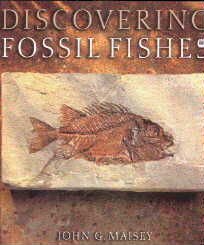
DISCOVERY FOSSIL FISHES
By John G. Maisey
AMERICAN MUSEUM OF NATURAL HISTORY
HENRY HOLT AND COMPANY - New York
Copyright ©1996 by John G. Maisey.
STATED: FIRST EDITION, 1996
NUMBER LINE: 10 9 8 7 6 5 4 3 2 1
Printed in Italy.
DISCOVERING FOSSIL FISHES
(from the dust-jacket end-flaps)
FISHES have a unique evolutionary history that stretches back in time more than 450 million years. They are incredibly ancient, older than the dinosaurs, and include the ancestors of all limbed vertebrates living on land, even humans. Not only are humans and fishes related, some fishes are more closely related to humans than they are to other fishes! We commonly think of ourselves as completely separate from our aquatic ancestors when instead we should be marveling at the similarities.
In Discovering Fossil Fishes, John Maisey traces the evolution of fishes over the course of 500 million years, describing the discovery of their extraordinary fossil remains and explaining what these ancient animals tell us about our own place in the history of life. Combining current scientific information with entertaining tales about historic and contemporary fieldwork, Maisey brings to life the development of armored fishes, monster sharks, and fishes with arms as he reveals the subtleties of evolution's greatest success story.
More abundant and more diverse than their air-breathing cousins, fishes today dominate the seas and freshwaters of Earth. Through outstanding full-color photographs of their fossils and of fossil reconstructions by artists David Miller and Ivy Rutzky, along with informative photographs, charts, diagrams, and drawings, we discover a staggering half-billion-year history in which lies our own watery origins.
Hard-back book measures roughly ~9-3/8" by ~10-3/8" (portrait); ~3/4" thick; 223 pages; no tears or folds in pages; binding fully intact. Book and dust-jacket are in very-fine "NEW" condition.
Price is $19.99 U.S. (originally published at $40 US !!!)
Return to top of page.
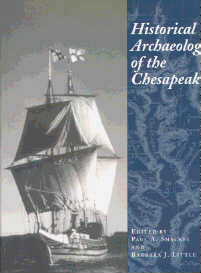
HISTORICAL ARCHAEOLOGY
of the CHESAPEAKE
Edited by Paul A. Shackel and Barbara J. Little
SMITHSONIAN INSTITUTION PRESS - Washington and London
Copyright ©1994 by the Smithsonian Institution
NUMBER/PRINT LINE: 02 01 00 99 98 97 96 95 94
10 9 8 7 6 5 4 3 2 1
ISBN: 1-56098-257-8
Library of Congress Catalog Card Number: 93-29078
Manufactured in the United States of America.
HISTORICAL ARCHAEOLOGY of the CHESAPEAKE
(from the dust-jacket end-flaps)
The Chesapeake Bay area's economy, ecology, and history have made it an extraordinarily rich area for archaeological study for nearly a century. Ranging across many methods of historical archaeology, this volume represents current work on the Chesapeake's western shore dealing with early European settlements, plantations and landscapes, and eighteenth- and nineteenth-century life.
Historical Archaeology of the Chesapeake presents a history of past excavations, as well as a sampling of recent historical archaeological discoveries. The essays include an examination of seventeenth-century decorated tobacco pipes as evidence of possible African-made material culture, a detailed analysis of the decline of Alexandria's sugar industry, and a comparison of household objects from a working-class neighborhood with those of the nearby Hooker's Division, once the red-light district of Washington, D.C.
Using an array of theoretical orientations, the contributors analyze relationships among Native Americans, Europeans, and Africans, as well as among economic and occupational groups. Their findings illuminate changing social and political situations, including stratification within cities, between urban and rural areas, and between the Old and New Worlds.
Hard-back book measures roughly ~8-3/4" by ~11-3/8" (portrait); ~1" thick; 299 pages, no tears or folds; binding fully intact. Book and dust-jacket are in very-fine "NEW" condition.
Price is $24.99 U.S. (originally published at $49 US !!!)
Return to top of page.
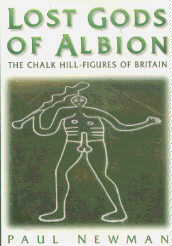
LOST GODS OF ALBION:
THE CHALK HILL-FIGURES OF BRITAIN
By Paul Newman
WRENS PARK PUBLISHING - UK - 2000
Copyright ©1987, 1997 by Paul Newman.
ISBN: 0-905-778-472
Printed in Great Britain.
LOST GODS OF ALBION
(from the dust-jacket end-flaps)
“The delight of this book is that it is a well-read and wry survey of the extraordinary variety of response and interpretation the hill-figures have evoked down the centuries.” - Richard Mabey, The Daily Telegraph
The flowing outlines of the Uffington White Horse, the phallic symbolism of the Cerne Giant, the austere Long Man of Wilmington and many other chalk hill-figures form some of Britain's best-known landmarks. As a uniquely British phenomenon, the thirty or so figures cut into the turf of southern England have excited antiquarians, archaeologists and the general public for generations. However, their origins are enigmatic. Paul Newman shows how hill-figures reveal Britain's darkest past: Druid massacres, conjectured human sacrifice and strange phallic and pagan rites that in milder form survive even today.
Lost Gods of Albion is the authoritative guide to a fascinating and mysterious subject. First published to wide acclaim in 1987, it has been completely rewritten and freshly illustrated, and incorporates radical new interpretations arising from the latest discoveries and researches. This scholarly and comprehensive account of all the recorded hill-figures in England offers not only description but also analysis, discussion and interpretation. In the ten years that have passed since the first edition of this book, much has changed in the world of hill-figure studies, most significantly perhaps the absolute dating by scientific means of early silts incorporated into the Uffington White Horse, which can now be seen to date from around 1000 BC.
These and other discoveries and reinterpretations are among the many features which make Paul Newman's book essential reading for all those who have been captivated by the potent symbolism of chalk hill-figures.
Hard-back book measures roughly ~7" by ~9-7/8" (portrait); ~3/4" thick; 216 pages; no tears or folds in pages; binding fully intact. Book and dust-jacket are in very-fine "NEW" condition.
Price is $14.99 U.S.
Return to top of page.
Scandals in the House of Birds |
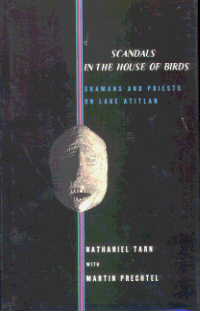
SCANDALS in the HOUSE of BIRDS
SHAMANS and PRIESTS on LAKE ATITLAN
By Nathaniel Tarn with Martin Prechtel
MARSILIO PUBLISHERS - New York
Copyright ©1997 by Nathaniel Tarn
ISBN: 1-56886-044-7
Library of Congress Catalog Card Number: 98-4887
Printed in the United States of America.
SCANDALS in th HOUSE of BIRDS
(from the dust-jacket end-flaps)
Based on a thirty-year span of fieldwork in the Lake Atitlan region of Guatemala, Scandals in the House of Birds is a multi-voiced epic of a sacred crime, and its tangled mythic, religious, and political ramifications. The Maximon, a wooden statue venerated since pre-Columbian times, is stolen from the local villagers, sent to a European museum, and finally returned decades later, largely thanks to the authors' intervention.
Hard-back book measures roughly ~5-3/4" by ~8-7/8" (portrait); ~1" thick; 397 pages, no tears or folds; binding fully intact. Book and dust-jacket are in very-fine "NEW" condition.
Price is $9.99 U.S.
Return to top of page.
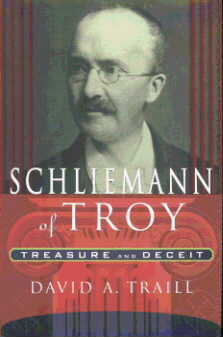
SCHLIEMANN of TROY
TREASURE and DECEIPT
By David A. Traill
ST. MARTIN'S PRESS - New York
Copyright ©1995 by David A. Traill
STATED: FIRST U.S. EDITION, DECEMBER 1995
NUMBER LINE: 10 9 8 7 6 5 4 3 2 1
Library of Congress Catalog Card Number: 95-40767
ISBN: 0-312-14042-8
Printed in the United States of America.
SCHLIEMANN of TROY
(from the dust-jacket end-flaps)
Drawing on unpublished correspondence and diary excerpts, David Traill argues that Heinrich Schliemann, the famed discoverer of ancient Troy, may have perpetrated some of the greatest frauds of archaeological history
Standing proudly on a hill near Hisarlik, Turkey, in 1868, Heinrich Schliemann claimed that beneath hill feet lay the ancient city of Troy, immortalized by Homer in the Iliad. To the consternation of contemporary scholars, Schliemann substantiated his claims and popularized the belief that the Homeric legends have some basis in fact. He unearthed 'Priam's Treasure" at the site, bringing a glimmering but pivotal age into much sharper focus. By the time he excavated Mycenae in 1816 and delivered to the world the golden “Mask of Agamemnon,” he has earned a huge reputation that went largely unchallenged for decades.
However, in Schliemann of Troy, classicist David Traill investigates the archaeologist's own legends, and argues convincingly that Schliemann regularly distorted facts in both his personal and professional lives. Basing his biography on a thorough re-examination of the vast collection of Schliemann papers in Athens and including many previously unpublished excerpts from his letters and diaries, Traill demonstrates that his subject was a remarkably unscrupulous and untruthful individual.
For instance, Traill points out that Schliemann's account of the discovery of "Priam's Treasure" is replete with inconsistencies, including altered dates and findspots, and serious discrepancies over what was actually found. Schliemann falsely claimed that his wife Sophia helped him excavate the treasure, when she had actually returned to Athens weeks before the discovery. Instead of a single, huge find, Traill suggests that "Priam's Treasure" is a bogus cache of artifacts manufactured by Schliemann from several smaller finds made over a period of several months. Traill even exposes as false Schliemann's claim that the excavation of Troy was a dream he had cherished since childhood. The Schliemann who thus emerges from these pages - devious, ruthless, mendacious, egotistical - is a less noble but far more fascinating figure than previously believed.
At once a gripping portrait of a duplicitous man and a reinterpretation of some of the greatest archaeological discoveries of all time, Schliemann of Troy shakes the dust off of the Schliemann corpus and rewrites one of history’s most exciting chapters.
DAVID TRAILL, who is professor of classics at the University of California, Davis, has studied Heinrich Schliemann for nearly two decades. He lives in Davis, California.
Hard-back book measures roughly ~6-1/4" by ~9-1/2" (portrait); ~1-1/8" thick; 365 pages; no tears or folds in pages; binding fully intact. Book and dust-jacket are in fine to very-fine "UNUSED" condition.
Price is $9.99 U.S. (publisher's price was $24.95 !!!)
Return to top of page.
Index to Other Pages |
Arms to Armor's Home Page |
This Page Accessed
|
©1998, 1999, 2000 - C. Alan Russell - All rights reserved. |